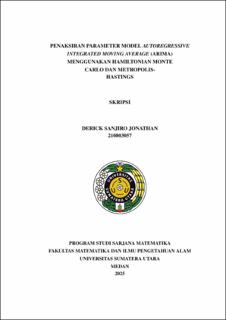Penaksiran Parameter Model Autoregressive Integrated Moving Average (ARIMA) Menggunakan Hamiltonian Monte Carlo dan Metropolis-Hastings
Parameter Estimation Of The Autoregressive Integrated Moving Average (ARIMA) Model Using Hamiltonian Monte Carlo And Metropolis-Hastings

Date
2025Author
Jonathan, Derick Sanjiro
Advisor(s)
Sutarman, Sutarman
Metadata
Show full item recordAbstract
Currency exchange rate is one of the key economic indicators that reflects a country’s stability and competitiveness. The selling rate of USD against the Indonesian Rupiah exhibits significant fluctuations, thereby requiring quantitative analysis to more accurately capture its movement patterns. This study aims to estimate the parameters of an Autoregressive Integrated Moving Average (ARIMA) model for the USD/IDR selling rate using three approaches: Maximum Likelihood Estimation (MLE), Hamiltonian Monte Carlo (HMC), and Metropolis–Hastings (MH). Model selection was carried out based on the Akaike Information Criterion (AIC) and the Bayesian Information Criterion (BIC), while the prior distribution for HMC and MH was determined based on the MLE estimates. The HMC method was implemented through a numerical approach using the leapfrog integrator, whereas the MH method employed a symmetric Gaussian proposal distribution. Model performance was evaluated by comparing one-step-ahead forecasts on both real-world and simulated data, using Mean Absolute Error (MAE), Mean Squared Error (MSE), and Mean Absolute Percentage Error (MAPE) as evaluation metrics. The results indicate that for the real-world data, MLE achieved the best accuracy with an MAE of 86.75, lower than MH 87.1 and HMC 87.27. For the simulated data, MLE also produced the lowest MAE of 26.82, compared to MH 29.58 and HMC 29.63. The MSE and MAPE results were consistent with these findings. These results confirm that MLE outperforms the other methods in both real-world and simulated data, while HMC and MH remain valid approaches that additionally provide posterior distributions, enabling a more comprehensive assessment of parameter uncertainty.
Collections
- Undergraduate Theses [1486]
